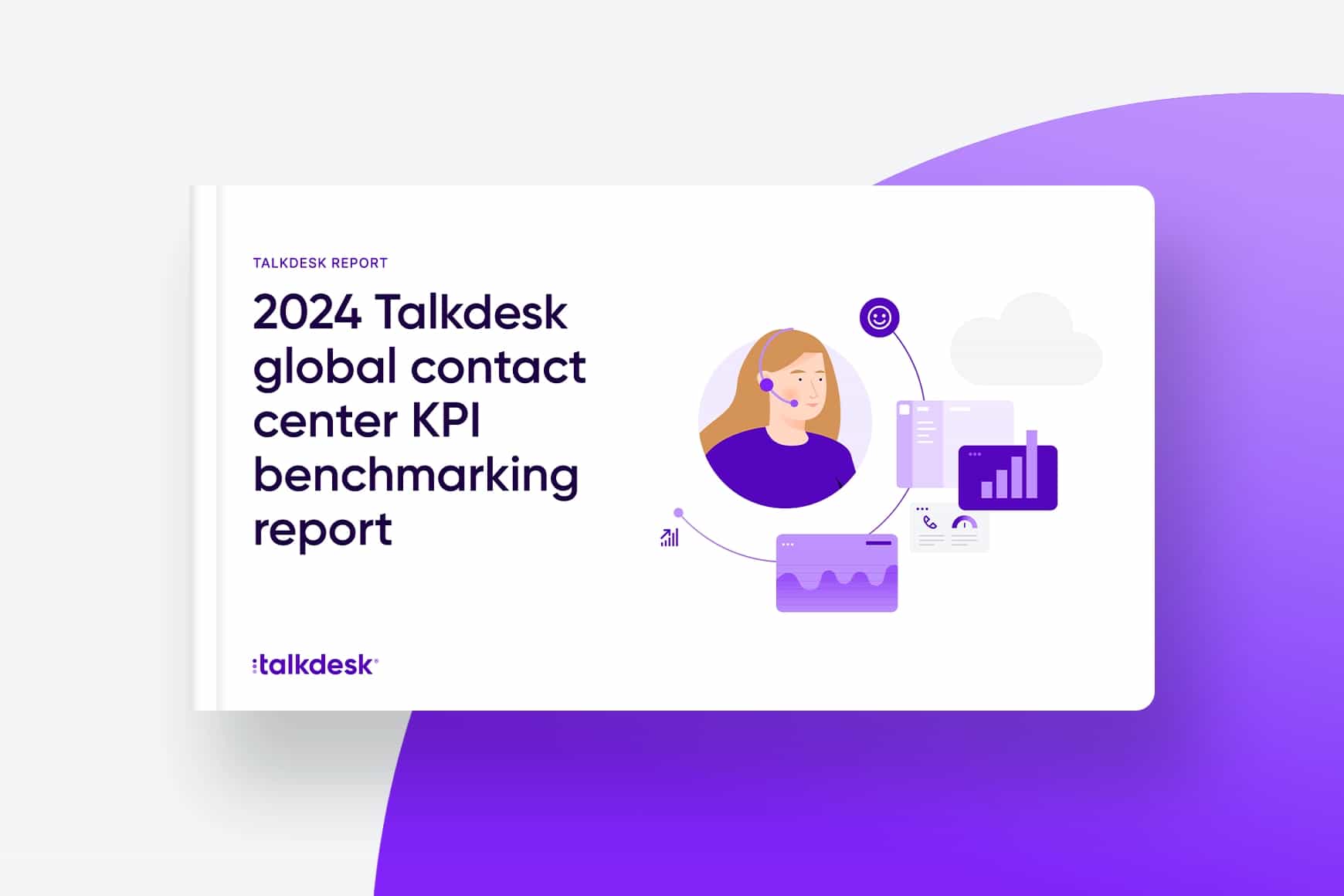What is average handle time (AHT) and how to improve it in your contact center

By Celia Cerdeira
0 min read

The best contact center managers understand that delivering a top-notch customer experience goes hand in hand with focusing on the right data.
It’s not just about happy customers—it’s about understanding what drives those interactions through smart analytics. That’s why tracking key performance indicators (KPIs) such as first contact resolution rate, Net Promoter Score (NPS), agent turnover rate, and average handle time (AHT) is so important.
AHT, in particular, is a crucial metric for balancing efficiency and customer satisfaction. By understanding and optimizing AHT, a contact center can operate more effectively while ensuring customers feel heard and supported.
This guide explains everything a contact center manager needs to know about average handle time, including causes and practical tips for improving it.
What is average handle time (AHT)?
Average handle time (AHT) is a core metric that helps contact centers understand how long it takes to handle a customer interaction from start to finish. It includes talk time, hold time, and the after-call work (ACW) that contact center agents complete once a conversation ends.
The formula for calculating average handle time is as follows:
(Talk Time + Hold Time + ACW Time for Handled Contacts) / (Handled Contacts)
Talk time refers to how long an agent speaks with the customer, while hold time refers to how long the customer is placed on hold. After-call work (ACW) includes all the necessary tasks that follow the interaction, like logging notes or updating records.
AHT reflects both the efficiency and quality of customer experience. A lower AHT can indicate that customers are getting their issues resolved quickly, but an AHT that’s too brief could mean agents are rushing through interactions, possibly at the cost of quality. If agents rush to provide quick answers just to handle more interactions, customers may reach out multiple times for the same issue.
A higher AHT might signal that agents are spending extra time addressing complex issues, which can be positive if customers are satisfied. However, it might also reflect inefficient processes, complex inquiries, or agents struggling to find the right information. Balancing AHT is key to ensuring customers feel supported while making the best use of resources.
While average handle time began as a traditional call center metric, measuring how long it took to complete a typical customer service call, it has now evolved into a measure for multiple communication channels. Whether a customer reaches out via phone, chat, or email, AHT helps contact center managers understand and improve agent performance across all channels, strengthening their omnichannel strategy and ultimately enhancing the customer experience.

Talkdesk Report
Talkdesk 2024 KPI benchmarking report for contact centers
Get a snapshot of your contact center’s performance in the age of generative AI, see how it compares to industry peers, and discover tips for optimization.
Why do contact centers need to track average handle time?
Tracking average handle time gives contact centers valuable insights into their operational efficiency and customer satisfaction. It’s not just about knowing how long each interaction takes. It’s about understanding the quality of service, resource use, and the overall customer experience.
Keeping track of AHT allows contact centers to:
Evaluate performance.
AHT provides a metric for evaluating the performance of individual agents, customer care teams, and the entire contact center. Comparing AHT across different agents or teams helps identify top performers and highlight areas for improvement. This data also supports targeted coaching to enhance the quality of customer interactions.
Allocate resources effectively.
Understanding the AHT required to handle specific types of customer queries helps determine appropriate staffing levels and schedule agents accordingly, reducing wait times and improving service levels. For instance, if AHT tends to peak after releasing a new software or product feature, additional agents can be assigned in advance when planning future releases.
Optimize processes.
Analyzing AHT can reveal bottlenecks, inefficient workflows, or complex procedures that contribute to longer handle times. For example, instead of relying on multiple complicated security questions to authenticate customers, contact centers could implement voice recognition software to streamline the process.
With the importance of tracking average handle time established, it’s time to explore what makes an effective AHT and how to determine if it’s on target.
What is a good average handle time?
A good average handle time is not one-size-fits-all; it varies based on several factors, such as the industry, the complexity of the product or service, and the contact center’s overall customer service strategy.
As a general target, aiming for around six minutes per contact is a reasonable starting point. However, this number can go up or down depending on specific factors like the nature of customer inquiries or the complexity of the service being offered.
To determine if AHT is on target, evaluate it alongside other customer service metrics like the Net Promoter Score (NPS) and customer satisfaction score (CSAT). If customers are happy with both the speed and quality of their interactions, AHT is likely in a healthy range. The goal is to find a balance that maximizes efficiency while also improving first call resolution (FCR), ensuring that customers don’t need to call back for the same issue.
How to improve average handle time: 5 strategies for contact center agents.
Optimizing average handle time is key to running an efficient contact center without losing sight of what matters: giving each customer a great experience. It’s all about finding that balance—improving AHT doesn’t mean agents should rush through calls or cut corners— and using smart strategies to streamline processes, empower agents, and make the best use of the tools at hand.
1. Train agents to provide fast, accurate solutions.
Proper agent training is key to keeping average handle time in check. When agents lack the skills or knowledge they need, interactions take longer, and both customers and agents get frustrated. Regular training helps agents handle complex issues quickly, while embedding good customer service techniques into the contact center culture ensures everyone is on the same page. Plus, using AI tools to provide real-time recommendations can make agents even more effective.
2. Map the customer journey.
Average handle time isn’t just about agent performance—it also reflects how well (or poorly) a contact center’s processes are working. Mapping the customer journey helps identify inefficiencies contributing to longer handle times. By taking a close look at each step a customer takes, contact center managers can pinpoint where things get bogged down. Once those roadblocks are identified, it’s easier to simplify, automate, or remove them leading to smoother interactions and shorter AHT.
3. Choose the right contact center technology.
The right contact center technology can make all the difference in reducing average handle time. By streamlining each part of the AHT equation—talk time, hold time, and after-call work—technology can help agents work more efficiently and improve the overall customer experience. Here are some key tools that can elevate outcomes across a contact center:
-
Self-service chatbots. Let customers find answers to common questions on their own, reducing the need for agent intervention.
-
Omnichannel customer journey mapping. Track customer interactions across all channels to provide agents with context, which helps them resolve issues faster.
-
AI-powered agent assistance. Provide real-time recommendations and insights to agents, helping them deliver quick and accurate responses.
Contact center software is vital in improving AHT, offering solutions that reduce manual tasks and enhance efficiency. With the right technology, contact centers can optimize workflows, assist agents more effectively, and ultimately deliver faster, better service to customers.
4. Reduce after-call work.
Customer service suffers when agents are overwhelmed with excessive after-call work or administrative tasks during the interaction. In a busy contact center environment, agents need to stay focused and provide their full attention to customers.
To help agents do that, automate as much of the repetitive stuff as possible. AI tools can take notes during calls, compile after-call summaries automatically, and handle routine tasks—letting agents focus on what matters: helping customers. By cutting down on distractions and streamlining after-call work, agents can handle each interaction more efficiently and get ready for the next one faster.
5. Build a deep knowledge base.
Having a comprehensive knowledge base is a game-changer for reducing average handle time, and two key features make it work effectively:
-
Knowledge base management system for agents. A well-organized knowledge base gives agents quick access to the information they need, whether product details, troubleshooting steps, or answers to common questions. With a faster way to find accurate answers, agents can resolve customer issues more efficiently.
-
Self-service resources for customers. Providing online guides, FAQs, and troubleshooting resources allows customers to find solutions on their own, without needing to contact an agent. These resources can help customers solve common problems, saving them and the contact center time.
By combining these strategies, a knowledge base can empower agents and customers, leading to shorter handle times and more satisfied customers.
Reduce average handling time with the Talkdesk AI-powered contact center platform.
Optimizing average handle time is all about finding that perfect balance between efficiency and quality service. Contact centers can boost performance and improve customer satisfaction by training agents, mapping the customer journey, using the right technology, minimizing multitasking, and building a deep knowledge base.
Learn more about how the Talkdesk AI-powered contact center platform can help organizations reduce average handle time. Talkdesk offers tools like automatic call summaries, real-time recommendations, and automation for repetitive tasks—everything needed to streamline processes and deliver exceptional customer experiences.
FAQs.
Here are some of the most common questions contact centers have about average handle time and its role in optimizing customer service.
Why is average handle time an important call center metric?
Average handle time reflects operational efficiency and the quality of the customer experience. Optimizing it helps improve service levels, increase customer satisfaction, and enhance overall contact center productivity.
How do I calculate average handle time?
The calculation for average handle time uses the following KPIs:
Total interaction time. The duration of the actual interaction with the customer.
Total hold time. The time customers spend on hold during the interaction.
Total transfer time. The time customers spend being transferred to different agents or channels.
After-call work time. The time spent on post-interaction tasks, and any associated wrap-up or administrative tasks.
Take the metrics above and plug them into this formula to calculate AHT: (Talk Time + Hold Time + ACW Time for Handled Contacts) / (Handled Contacts)
How can my organization improve average handle time?
Organizations can improve average handle time by training agents to handle inquiries more efficiently, using AI tools to automate repetitive tasks, building a comprehensive knowledge base, optimizing customer journey processes, and leveraging the right contact center technology to support agents and streamline workflows.





